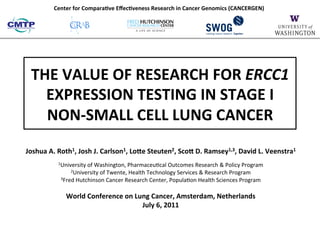
Roth_World Conference on Lung Cancer 2011-The Value of Research for ERCC1 Expression Testing in Stage I Non-Small Cell Lung Cancer
- 1. Center for ComparaSve EffecSveness Research in Cancer Genomics (CANCERGEN) THE VALUE OF RESEARCH FOR ERCC1 EXPRESSION TESTING IN STAGE I NON-‐SMALL CELL LUNG CANCER Joshua A. Roth1, Josh J. Carlson1, LoBe Steuten2, ScoB D. Ramsey1,3, David L. Veenstra1 1University of Washington, Pharmaceu7cal Outcomes Research & Policy Program 2University of Twente, Health Technology Services & Research Program 3Fred Hutchinson Cancer Research Center, Popula7on Health Sciences Program World Conference on Lung Cancer, Amsterdam, Netherlands July 6, 2011
- 2. Background: ERCC1 TesSng & Study ObjecSve • Biomarkers may be able to iden7fy Stage I pa7ent sub-‐ groups that will benefit from pla7num-‐based regimens • ERCC1 is a protein involved in DNA damage repair. Pa7ents with low ERCC1 expression in tumors may derive survival benefit from pla7num regimens, but there is uncertainty. • Should addi7onal studies be conducted to reduce uncertainty before use in clinical prac7ce? • Using a decision model, we calculated the value of addi7onal ERCC1 tes7ng trials to address this ques7on Olaussen et al., NEJM, 2006; Bepler et al., American Journal of Pathology, 2011 2
- 3. Background: Decision Modeling • Models can synthesize exis7ng clinical and cost data to allow comparison of ERCC1 and standard care strategies • Quality-‐adjusted life years (QALYs) can be calculated by tracking survival and quality of life in different health states • The net-‐benefit can be calculated and compared between strategies to assess uncertainty and inform decisions: Quality- Willingness Cost of Net-Benefit = Adjusted * to Pay Per - Strategy Life Years QALY Ades et al., Medical Decision Making, 2004; Koerkamp et al., Value in Health, 2010 3
- 4. Background: CalculaSng Value of Research (VOR) • VOR is the societal value associated with reducing uncertainty, and making op7mal decisions more o_en • VOR can be calculated by examining two factors over many model simula7ons: 1. How o_en the non-‐op7mal strategy results in greater net-‐benefit 2. The magnitude of the net-‐benefit difference between strategies in simula7ons where 1 occurs Claxton et al., Health Economics, 1996; Ades et al., Medical Decision Making, 2004; Koerkamp et al., Value in Health, 2010 4
- 5. Methods: Model Inputs & Structure Mean Years Overall Survival With No Chemo No Adjuvant 5.42 (4.34-6.50) Zheng, NEJM, 2007 Chemotherapy High ERCC1 Hazard Ratio, Chemo vs. No Chemo Expression 1.01 (0.74-1.38) Bepler, Am J Path, 2011 Receive Adjuvant Chemotherapy Proportion Choosing to Receive Chemo 0.10 (0.05-0.15) Assumption ERCC1 Expression Testing Mean Years Overall Survival With No Chemo No Adjuvant 5.27 (4.22-6.32) Zheng, NEJM, 2007 Chemotherapy Low ERCC1 Hazard Ratio, Chemo vs. No Chemo Expression 0.83 (0.49-1.17) Ryu, Kor J Path, 2011 Receive Resected Adjuvant Chemotherapy Proportion Choosing to Receive Chemo Stage I NSCLC Patients 0.50 (0.05-0.95) Assumption Mean Years Overall Survival With No Chemo No Adjuvant 5.34 (4.27-6.40) Calculated From Sub-Groups Chemotherapy Hazard Ratio, Chemo vs. No Chemo Standard Care Receive 1.01 (0.78-1.30) Douillard, J Thor Onc, 2010 Adjuvant Chemotherapy Proportion Choosing to Receive Chemo 0.10 (0.05-0.15) Gray, J Clin Onc, 2010 *All pa7ents are followed for adverse events, distant recurrence, and death 5
- 6. Results: EsSmaSng the Maximum VOR Maximum Value of Research (VOR) at $150,000 per QALY for U.S. Population Per Patient Maximum VOR % of Simulations With Non-Optimal Decision: 39% Average Consequence of Non-Optimal Decision: $9,238 Per Patient Maximum VOR: $3,603 U.S. Affected Population % Running Count Reference Incidence of Lung Cancer in the U.S.: 222,000 ACS, 2010 Non-Small Cell Lung Cancer: 85.0% 188,700 ACS, 2010 Stage I Non-Small Cell Lung Cancer: 16.4% 30,947 SEER, 2010 Rate of Technology Diffusion Year 1 Cumulative Diffusion: 2.5% Year 5 Cumulative Diffusion: 54.0% Year 10 Cumulative Diffusion: 100.0% 10-Year U.S. Population Maximum VOR Population Maximum VOR: $459,377,000 • The maximum VOR is large because: 1. There is substan7al uncertainty about the op7mal strategy 2. The consequences of non-‐op7mal decisions are large 3. The 10-‐year affected popula7on is large 6
- 7. Results: VOR for Variables in a Trial $500,000,000 $459,377,000 $450,000,000 $400,000,000 Value of Research (VOR) $350,000,000 $310,529,000 $300,000,000 $250,000,000 $200,000,000 $150,000,000 $100,000,000 $42,650,000 $50,000,000 $23,830,000 $733,000 $122,000 $0 Maximum VOR Low ERCC1 Low ERCC1 Low ERCC1 High ERCC1 Proportion HR Long-Term Chemo HR High ERCC1 Survival Decisions Variables *The values above reflect the VOR for a new trial with 300 pa7ents per arm 7
- 8. Results: VOR for Sample Sizes in a Trial $500,000,000 $450,000,000 $400,000,000 Value of Research (VOR) $350,000,000 VOR for Trial $300,000,000 $250,000,000 Maximum VOR $200,000,000 Cost of $150,000,000 Trial $100,000,000 $50,000,000 $0 0 100 200 300 400 500 600 700 800 900 1,000 New Trial Sample Size (Per Arm) *These values represent a new randomized trial to examine 5-‐year overall survival 8
- 9. LimitaSons & Conclusions • There is lidle evidence about chemotherapy decisions in Stage 1 NSCLC, or in ERCC1 strategies • There may be feasibility issues that are not captured in the model and could prohibit trials • VOR analysis can be used to inform study design and priori7ze research investments • Significant societal value could be realized through addi7onal studies of ERCC1 tes7ng in Stage I NSCLC 9
- 10. Acknowledgements • David Veenstra • Rahber Thariani • Scod Ramsey • David Blough • Josh Carlson • Anirban Basu • Lode Steuten Supported in part by: U.S. Na7onal Cancer Ins7tute, Agency Award #5RC2CA148570-‐01, PI: Ramsey S PhRMA Founda7on Pre-‐Doctoral Fellowship in Compara7ve Effec7veness AFPE Pre-‐Doctoral Fellowship in Pharmaceu7cal Science 10